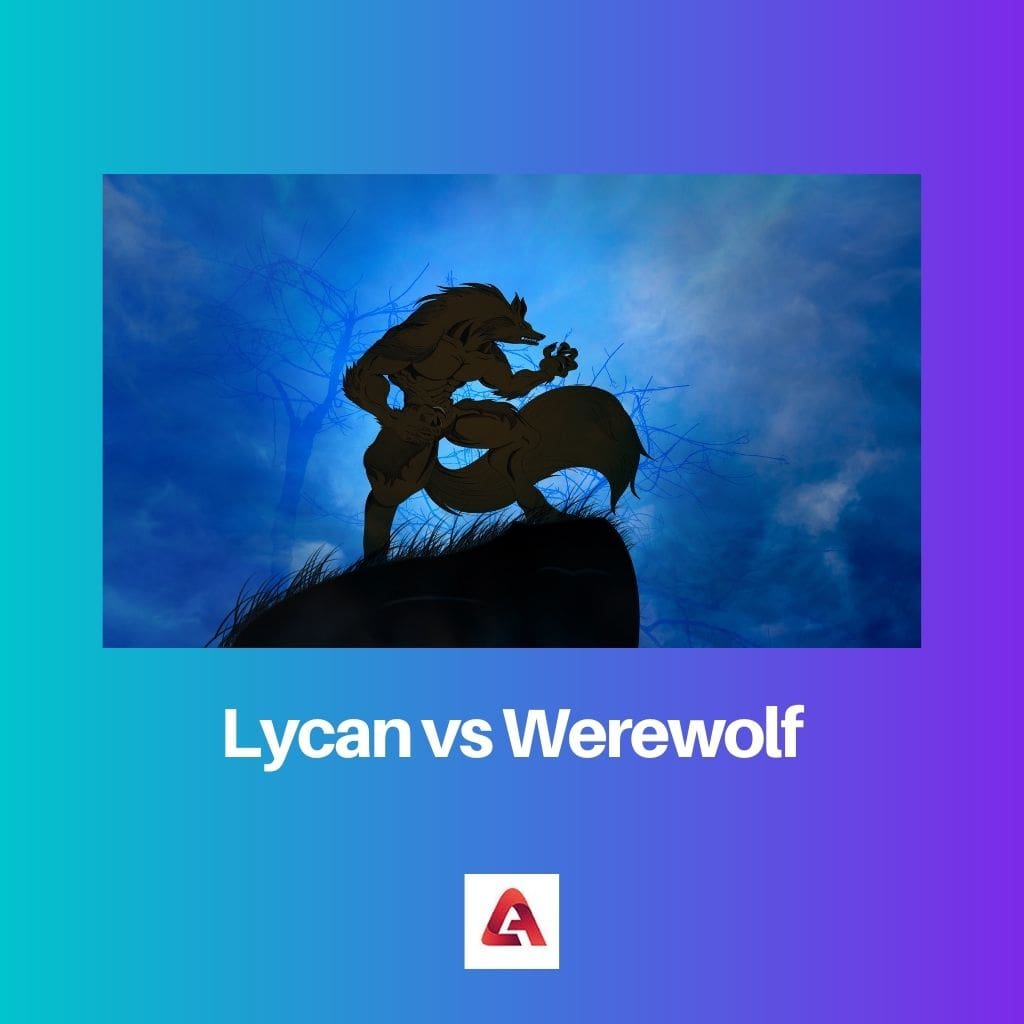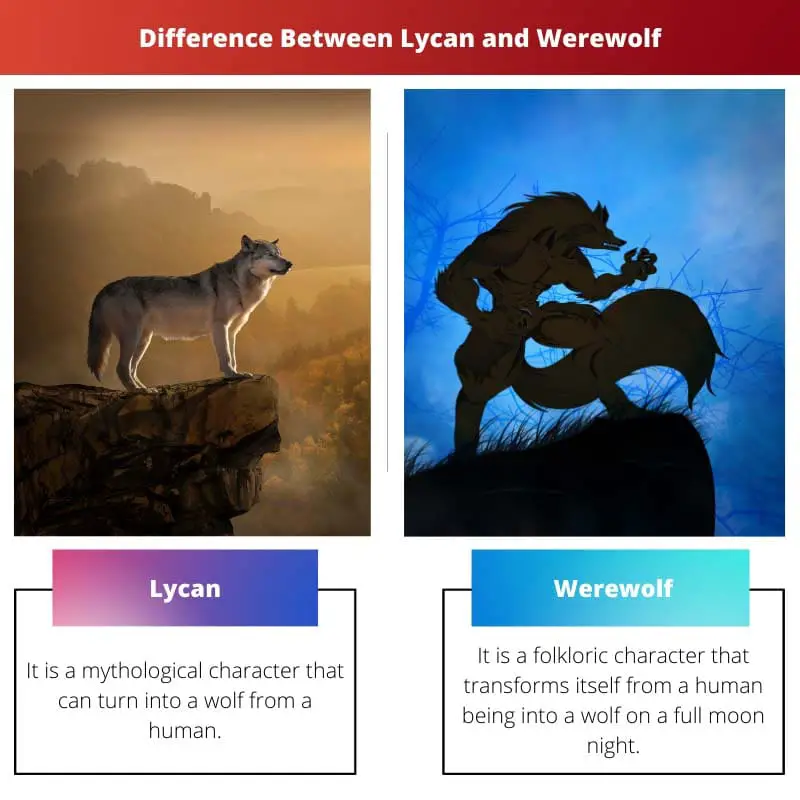Lycan and Werewolf are two different mythical or folkloric creatures. Although both transform into wolves from humans, they have considerable differences.
Key Takeaways
- Lycans and werewolves are mythical creatures able to transform between human and wolf forms.
- Lycans are portrayed as retaining control over their actions and thoughts during transformation, whereas werewolves lose control and become more animalistic.
- The terms are sometimes used interchangeably, but distinctions in control and transformation mechanics set them apart in certain narratives.
Lycan vs. Werewolf
A Lycan and a Werewolf differ because the former can shapeshift at any place or time. On the other hand, the latter transforms automatically on a whole moon night and can’t control such transformation. Also, the term Lycan was first mentioned in Greek folklore, while Werewolf traces its origin in old English folklore, specifically in the Americas following the Spanish invasion.

A Lycan is a mythological creature of Greek origin. Greek folklore described Lycan as a naked man who ran through the streets biting anyone he encountered using his bare teeth.
Some other folklore described it as lunacy. As time passed, these narratives transformed into what we know today as the story of men transforming into wolves.
On the other hand, Werewolf is a folkloric creature of English origin.
English folklore described Werewolf as a man who transformed into a wolf at night and gobbled humans, corpses, or animals. However, during the daytime, they transformed into human beings.
Comparison Table
| Parameter of Comparison | Lycan | Werewolf |
|---|---|---|
| Origin | Greek folklores | Old English folklore |
| Nature of transformation | Voluntary | Involuntary |
| Time of transformation | Anytime | Full moon night |
| Appearance | A full-fledged wolf of gigantic size. | A wolf is standing on two legs. |
| Effect of Silver | Causes weakness. | Causes death. |
What is Lycan?
It is a mythological character that can turn into a wolf from a human. Such a transformation is deliberate and can occur at any time or place. In other words, a Lycan can shapeshift at its will.
Some people consider Lycans to be of Transylvanian origin. But its first mention can be traced back to the times of Greek city-states.
In Greek folklore, Lycan is referred to as a naked man running on the streets and biting anyone whom he meets on his way.
Some other Greek narratives describe it as lunacy. Lycan is an abbreviated version of the term ‘Lycanthropy,’ which refers to a mental disorder in which a person thinks of himself as a wolf.
It is also used to refer to a viral disease called Rabies that is transmitted to humans through an animal bite, especially to stray dogs.
As the narratives of Lycans were passed from one generation to another, the form of the original stories was altered. Consequently, the story of a man turning into a wolf was born.
A human being turns into a Lycan when another Lycan bites him.
When a Lycan bites a person, the person feels excruciating pain, as if his body is on fire. But the discomfort lasts only for a few minutes.
Immediately after being bitten, the person transforms into a wolf and can return to his human form only after receiving his maker’s encouragement.
Lycans are smart, muscular, and difficult to kill. They look like a real wolves but bigger and with deadly claws. They symbolize a religious practice. *
The only weakness that a Lycan has is silver. However, it cannot kill them. They can be killed only if someone causes damage to their spine or separates their skull from their spine.
In popular culture, the mythical character of Lycan has been popularized by the film Underworld: Rise of the Lycans, released on 23rd January 2009.

What is Werewolf?
It is a folkloric character that transforms from a human into a wolf on a full moon night and preys on humans, animals, or dead bodies.
But such a transformation is not in the control of the concerned person. It happens automatically, and one cannot restrict it. However, the person returns to his human form once the night is over.
One can trace the origin of werewolves in old English folklore produced in the Americas after the Spanish invaded and settled there.
This proposition is further reinforced by the derivation of the term ‘werewolf,’ a combination of two different words found in old English. The times are ‘Wer,’ meaning ‘man,’ and ‘Wulf,’ meaning ‘wolf.’
A person is turned into a werewolf when another werewolf bites him. During transformation, the concerned person goes through tremendous bodily changes.
His bones lengthen and change their shape, sometimes so forcefully that it creates a rupture in the skin. The process lasts for several minutes, and the end product turns out to be a wolf with the posture of a human being.
Just like Lycans, Werewolves possess inhuman strength, speed, and agility. They have incredible senses that enable them to track anything.
Although they have the power of regeneration, they have weaknesses that can become the reason for their death, which is silver.
To kill a Werewolf, one must shoot or stab his heart or head with silver. Shooting is a safer option as it can save the person from being scratched or bitten by the werewolf.
There can be some medical explanations for the werewolf phenomenon, such as food poisoning, hypertrichosis (a genetic disorder that causes abnormal hair growth), rabies, or hallucination.
Another medical explanation for werewolf mania can be Pitt-Hopkins syndrome, discovered in 1978. It is a medical condition in which the person experiences seizures, difficulty breathing, aphonia, paralytics, and intellectual changes.
However, in earlier times, no scientific explanations existed for these conditions. Therefore, mythological creatures like Werewolves were used to describe these unexplainable conditions.
Nonetheless, in modern times Werewolves are nothing but one of the horror icons of popular culture. Their popularity is attributed to the 1941 Hollywood movie, The Wolf Man.

Main Differences Between Lycan and Werewolf
- Both Lycans and Werewolves are mythical creatures concerned with transforming humans into wolves. But in the case of Lycans, the transformation occurs at the will of the concerned person. While in the case of Werewolves, the change takes place involuntarily.
- A Lycan can transform itself at any place or time. At the same time, a Werewolf transforms itself on a whole moon night.
- Lycans are of Greek origin. At the same time, werewolves are of English origin.
- When a Lycan transforms, it looks like a giant wolf with lethal claws. At the same time, a werewolf looks like a wolf with a man’s posture on transformation.
- One must injure or separate the skull from his spine to kill a Lycan. A Werewolf can be killed by shooting or stabbing his head or heart with silver.


The article delves deep into the origins and characteristics of Lycans and Werewolves, providing a fascinating exploration of these mythical creatures. The narrative style and comparisons make for an engaging read.
I couldn’t agree more, Nikki! The article’s detailed analysis of Lycans and Werewolves is both informative and captivating.
The comparisons between Lycans and Werewolves are presented in a well-organized and detailed manner, offering readers a comprehensive understanding of these mythical creatures. It’s a thought-provoking and educational piece.
I completely agree, Justine86! The article’s analysis of Lycans and Werewolves is both enlightening and thought-provoking, providing valuable insights into their mythological origins.
The distinction between Lycan and Werewolf is truly captivating! I appreciate the clear comparison table and the historical origins of these mythical creatures.
Absolutely, Jessica03! The historical context provided in this article adds depth to our understanding of Lycans and Werewolves.
The article provides an interesting exploration of Lycans and Werewolves, offering a comprehensive comparison and historical context. It’s a well-researched and engaging piece.
I completely agree, Tom! The in-depth analysis of Lycans and Werewolves makes for a compelling and educational read.
The article presents a compelling comparison between Lycans and Werewolves, discussing their transformations, origins, and cultural significance in an engaging manner. It’s an illuminating piece.
Absolutely, Christopher! The detailed examination of Lycans and Werewolves offers valuable insights into their mythological origins and unique characteristics.
I found the analysis of Lycans and Werewolves to be thought-provoking and informative. The article provides a thorough exploration of these mythical creatures and their cultural contexts.
This article provides a thorough comparison between Lycan and Werewolf, shedding light on their origins, transformations, and weaknesses. It’s fascinating to learn about the differences in control and transformation mechanics between the two mythical creatures.
I completely agree, Palmer! The detailed explanation of their origins and nature of transformation was quite enlightening.
The comparisons between Lycans and Werewolves are clearly articulated in this article, offering valuable insights into their unique characteristics and origins. It’s a thought-provoking piece.
Absolutely, Caitlin! The article’s analysis of Lycans and Werewolves provides a nuanced understanding of these mythical creatures and their cultural significance.
The information about Lycans and Werewolves is presented in a very engaging manner. The detailed descriptions of their transformations and origins make for a fascinating read.
I found the comparison table particularly helpful in understanding the unique characteristics of Lycans and Werewolves. It’s an informative and well-structured piece.
I couldn’t agree more, Davis! The article’s narrative style certainly makes it an interesting exploration of these mythical creatures.
This article contains a wealth of information on Lycans and Werewolves. The historical context and comparisons are fascinating and add depth to the discussion of these mythical creatures.
I couldn’t agree more, Fpatel! The article’s detailed analysis of Lycans and Werewolves offers valuable insights into their origins and cultural significance.
The detailed explanations of Lycans and Werewolves are truly eye-opening. It’s intriguing to learn about the distinctions in their transformation mechanics and the cultural origins behind these creatures.
Absolutely, Bethany! The article provides a comprehensive understanding of Lycans and Werewolves, delving into their origins and unique characteristics.